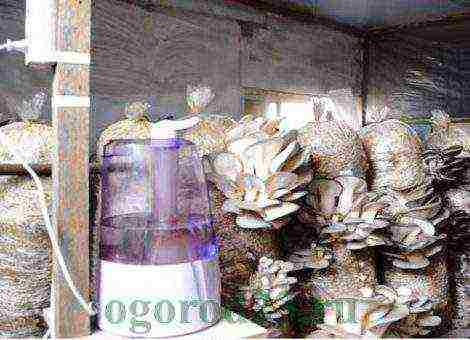Content
- 1 Vegetative growing method
- 2 Propagation of mint by seeds
- 3 How to grow mint at home: useful tips
- 4 Mint: outdoor growing conditions
- 5 Harvesting and storage
- 6 Diseases and pests
- 7 Home-grown mint varieties
- 8 How to grow mint at home?
- 9 How to grow mint from seeds on a windowsill?
- 10 How to plant mint by root layers and dividing the bush?
- 11 Growing mint at home using cuttings
- 12 Caring for mint grown on a windowsill
- 13 Timing of collecting mint at home
- 14 Growing methods
- 15 Video "How to grow mint"
- 16 Care
- 17 Video "The healing properties of mint"
- 18 What do you need
Its aroma is one of the most recognizable and beloved, the leaves are present in the kitchen supplies of almost every housewife, and its natural properties help relieve nervous tension and restore a healthy sound sleep.

Mint is a herb that has earned the respect of culinary craftsmen and experts in traditional medicine. How to grow mint at home yourself?
Characterized by jagged leaves and tiny pink, purple, white flowers, the perennial is widespread in the wild and cultivated horticulture. At home, mint is not a capricious and easily adaptable plant.
Vegetative growing method
How to grow mint at home? The most common method of propagation is vegetative, in which cuttings or rhizome cuttings with shoots can be used.

To obtain a cutting in the summer from an adult plant, you should cut off a twig with leaf nodules and place it in a glass of water or in the sand. After a week, you can see the appearance of small white roots. When they reach a decent length, the plant can be planted in a permanent place of growth. You can also get planting material by digging a mint bush in early autumn and dividing it into several parts. Each of them should have shoots with roots and several buds.
Propagation of mint by seeds
The seed method is less in demand and is quite lengthy. Typically, mint seeds are purchased in stores. They need to be planted in containers with barely damp soil to a depth of no more than 0.5 cm, create greenhouse conditions for them, covered with plastic wrap or glass. After 7-16 days, the mint seeds will sprout; the emerging and matured seedlings should be transplanted into pots and determined in cooler conditions for the purpose of gradual acclimatization. After 7-10 days, the young plant will be ready to be assigned to a permanent place of growth.
How to grow mint at home: useful tips
Mint can be grown both outdoors and as a pot plant. For indoor maintenance, in which the plant can be grown all year round, a drainage layer should be placed in the planting container, and a soil composition of 1 part humus and 2 parts of leafy soil should be used as a nutrient soil. Plant a new plant here.

Mint on the windowsill will feel good in the west or east side of the room, without direct sunlight on the green leaves. In summer, the plant will be comfortable on the balcony, in winter - on a lighted windowsill. In room conditions, it should be controlled that the soil is constantly moist, and there is always water in the pan of the pot.Mint on the windowsill needs regular watering with soft water at room temperature, it is also recommended to spray the leaves from time to time. A weekly shower during the warmer months will only benefit a fragrant room culture. With regular cutting off of leaves, it is recommended to feed the plant once a month.
Mint: outdoor growing conditions
When grown outdoors, mint should be placed in a sunny location in fertile, well-drained soil. The best precursors for mint are turnips, carrots, and potatoes. The planting depth of the seedling is 10-12 cm, the recommended distance between plants is 15-30 cm. The bush will root better if, when planting at a distance of 5 cm from the soil surface, its aboveground part is cut off.
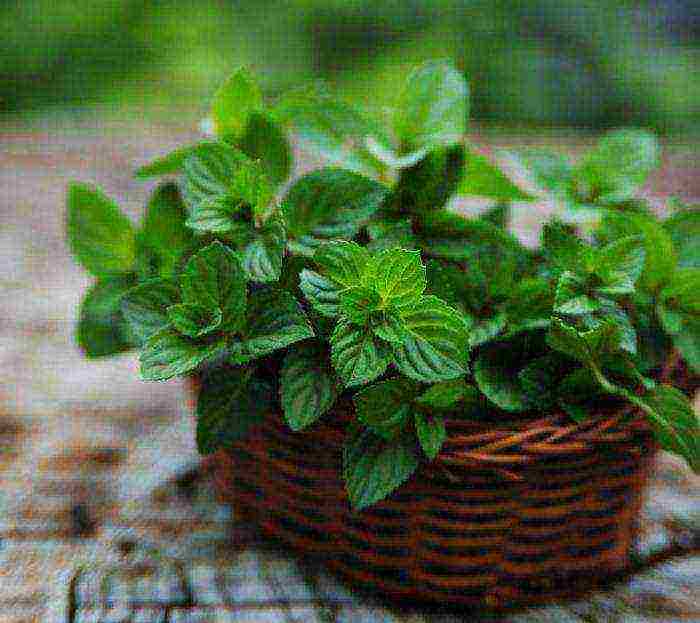
How to grow mint at home so that its reserves are not depleted? Mint tends to grow strongly. You can limit it in active growth to the sides by planting a bush in a wide container, which you can immerse in the ground. The planted plant will delight with young leaves in a couple of weeks. The top of the fragrant grass should be kept trimmed: this inhibits growth in height, causes overgrowth to the sides, thereby increasing the yield.
After planting, you can feed the mint with a urea solution at the rate of 2 grams of the drug per 1 liter of water. It is not recommended to fertilize the plant with nitrogen-containing agents: they will cause an active growth of the vegetative mass, which will negatively affect the accumulation of essential oils mint.
Harvesting and storage
Harvesting can begin in the second year after planting: about 3 cuts are made per season. It is best to harvest mint leaves during flowering (June – September) - it is at this moment that it has the highest content of essential oils.
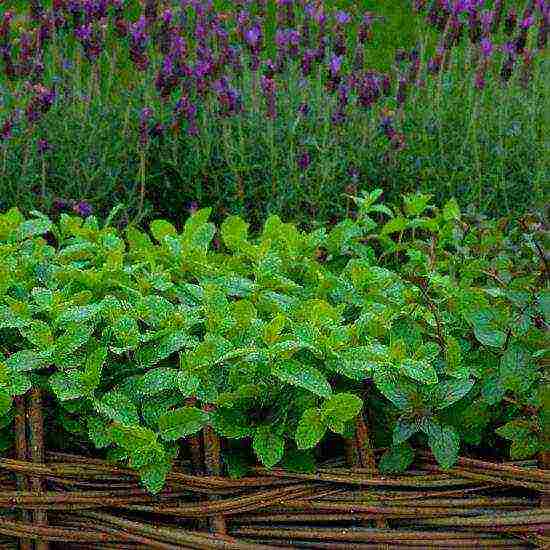
Dried leaves and petioles, which are the aromatic component of herbal tea and seasoning for dishes, should be stored in a dark place in a glass container. It is recommended to grow a garden culture in one place for no more than 4 years.
Diseases and pests
Mint can be affected by pests such as spider mites, slugs, whiteflies, and weevils. Keeping a plant healthy requires good air circulation in the soil and drainage. Insects, which tend to reside on the underside of leaves, can be rinsed off with a hose.
Home-grown mint varieties
On your own plot, you can plant several types of mint, or stop at one of them.
So, apple mint, characterized by a pleasant aroma and delicate refreshing taste, does not give bitterness and is tasty in compotes, jelly, jams. For culinary purposes, the entire aerial part of the plant is used. Green and variegated varieties, combining spicy and tasteful qualities with decorativeness, are characterized by wide ovoid leaves with a clearly visible thick pile. The height of the herbaceous bushes is about 70 cm.
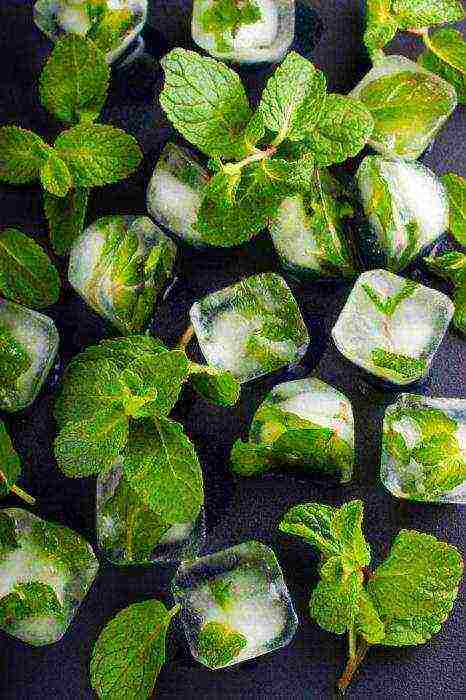
Curly mint is ideal for culinary purposes because it does not have the cold menthol flavor that peppermint has. The plant is characterized by strong stems and bright green, jagged leaves along the edges. Mint looks very nice in a pot, giving a year-round harvest when grown indoors.
Field mint fully reveals its qualities in tonic drinks. The long-leaved species contains a large amount of vitamin C and, due to the high content of essential oils, is successfully used in cosmetology and home soap making. Therefore, you should definitely acquire such a healthy culture on your own site, which is at the same time a medicine, a spice and a seasoning.
In cultural gardening, peppermint is widespread - a plant with creeping long roots, numerous branches with green egg-shaped leaves and miniature purple-pink inflorescences.Due to the high content of menthol, the aerial part of the grass emits a strong aroma and is characterized by a specific "cooling" taste.

Young mint greens are used to flavor drinks, sauces, desserts, fruit and vegetable dishes. Peppermint, which has sedative and antiseptic properties, is a constituent of many medicines, is effective in treating colds and improves digestion.
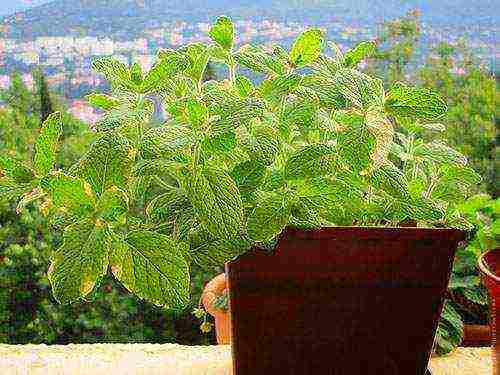 Mint and its closest related species, known as essential oil, spice and flavoring and medicinal crops, have long found their place in garden beds and gardens. But if during the summer the plants are regularly supplied with fresh greens, then with the arrival of autumn frosts, the gardener has to be content with frozen or dried mint in advance. And although these methods allow the plant to preserve most of the nutrients, such raw materials cannot be compared with green juicy leaves.
Mint and its closest related species, known as essential oil, spice and flavoring and medicinal crops, have long found their place in garden beds and gardens. But if during the summer the plants are regularly supplied with fresh greens, then with the arrival of autumn frosts, the gardener has to be content with frozen or dried mint in advance. And although these methods allow the plant to preserve most of the nutrients, such raw materials cannot be compared with green juicy leaves.
In order not to depend on the season and not to give up the mint greens containing menthol, vitamins, valuable acids and trace elements, when it is frosty outside and a blizzard is raging, you can plant mint on the windowsill.
How to grow mint at home?
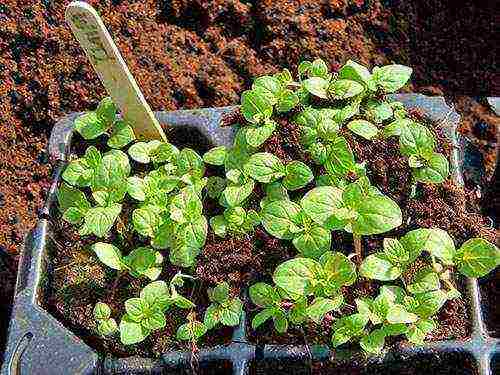 A perennial with a branched surface rhizome and many shoots extending from it can be easily grown at home. The main thing is to provide the plants with comfortable conditions, including adequate nutrition, lighting and watering.
A perennial with a branched surface rhizome and many shoots extending from it can be easily grown at home. The main thing is to provide the plants with comfortable conditions, including adequate nutrition, lighting and watering.
Mint feels best on loose soils with an average organic content and low acidity, in the range of 5-7 pH.
Before planting mint for plants, a soil mixture is prepared from two parts of garden soil, one part of humus, the same volume of peat and washed sand. To prevent the mint roots from getting wet, and there is no danger of decay, drainage must be done in a container for growing mint at home.
Since mint is quite unpretentious, you can propagate the plant:
- sowing seeds;
- root layers;
- cuttings;
- dividing an adult bush.
How to grow mint from seeds on a windowsill?
Seed propagation is the most laborious and time consuming method, but it cannot be avoided if you want to get a plant of a certain variety or type.
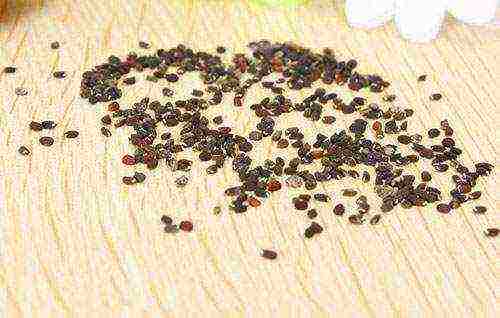 In order for the seedlings to be strong and friendly, it is better to give preference to purchased seeds. Not all hybrid species inherit their parental characteristics when collecting seed from them. So, for example, only a third of curly mint seedlings have curly foliage, and the rest of the seedlings are a simple garden variety. So how to plant mint seeds?
In order for the seedlings to be strong and friendly, it is better to give preference to purchased seeds. Not all hybrid species inherit their parental characteristics when collecting seed from them. So, for example, only a third of curly mint seedlings have curly foliage, and the rest of the seedlings are a simple garden variety. So how to plant mint seeds?
It is better to sow mint in March or April, in moistened soil to a depth of 0.5 cm. Sprinkle the seeds on top with a small amount of humus or nutrient soil and cover with glass or film. At room temperature, seedlings appear 14-18 days after sowing. Until this moment, it is necessary to monitor the moisture content of the soil, to prevent it from drying out or waterlogging. If necessary, the surface of the soil is carefully sprayed, trying not to disturb the small seeds, and the glass is slightly opened for ventilation.
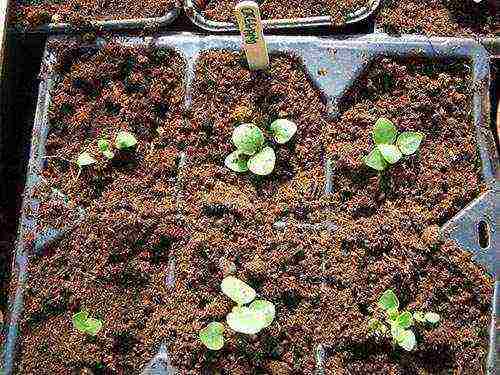 When the sprouts of mint on the windowsill give two true leaves, they are dived, seated in separate small containers or in a 5x5 pattern in a single wide container.
When the sprouts of mint on the windowsill give two true leaves, they are dived, seated in separate small containers or in a 5x5 pattern in a single wide container.
How to plant mint by root layers and dividing the bush?
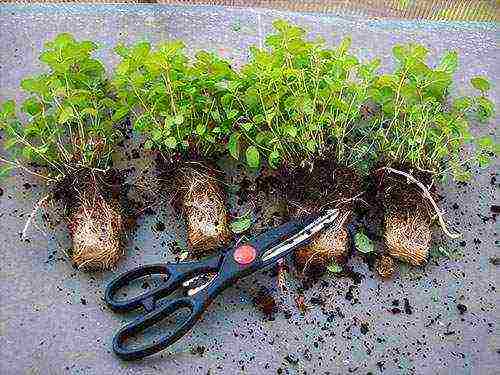 Gardeners and gardeners know how the mint that has taken root on the site quickly takes up new spaces. Long rhizomes with dormant buds are to blame for the predatory activity of the plant. The expanding root system of one plant gives life to new shoots and bushes. How to plant mint with root cuttings?
Gardeners and gardeners know how the mint that has taken root on the site quickly takes up new spaces. Long rhizomes with dormant buds are to blame for the predatory activity of the plant. The expanding root system of one plant gives life to new shoots and bushes. How to plant mint with root cuttings?
If you take advantage of this feature of mint, and in August or September stock up on root cuttings, about 10-12 cm long and two or three buds, then there will be no difficulty in the question of how to grow mint at home.Root layers are planted in moistened soil to a depth of 5–7 cm. If there are already developed shoots on such a cuttings, the roots are carefully preserved, and the aboveground part, after sprinkling with soil, is cut off at a height of 4–5 cm. The same is done with the planting material obtained after dividing the whole bush.
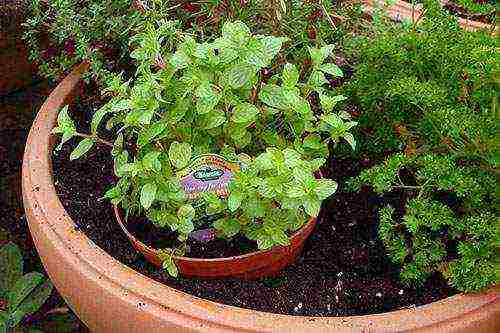 After two weeks, with proper care, indoor mint, as in the photo, forms dense green shoots and the first odorous leaves above the soil.
After two weeks, with proper care, indoor mint, as in the photo, forms dense green shoots and the first odorous leaves above the soil.
The same breeding methods are suitable for planting on the windowsill such herbs as oregano and thyme, which belong together with mint to the same family and have common habits and characteristics.
All of these crops are grown at home as perennials and require light but constant care.
Growing mint at home using cuttings
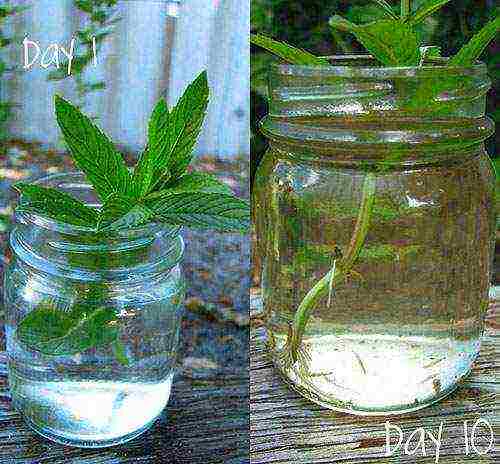 Cuttings cut from the top of the shoots of an adult bush are also suitable as planting material for growing mint on the windowsill. How to grow mint on the windowsill in this case? Twigs 6–8 cm long are dipped in a root solution and, after removing the two lower leaves, are placed in water. Roots sufficient for planting in the ground are formed after 7-15 days.
Cuttings cut from the top of the shoots of an adult bush are also suitable as planting material for growing mint on the windowsill. How to grow mint on the windowsill in this case? Twigs 6–8 cm long are dipped in a root solution and, after removing the two lower leaves, are placed in water. Roots sufficient for planting in the ground are formed after 7-15 days.
Two weeks after planting the rooted cuttings and the appearance of shoots on the planted root processes, the plants are fed with urea at the rate of 1 gram per liter of water.
Caring for mint grown on a windowsill
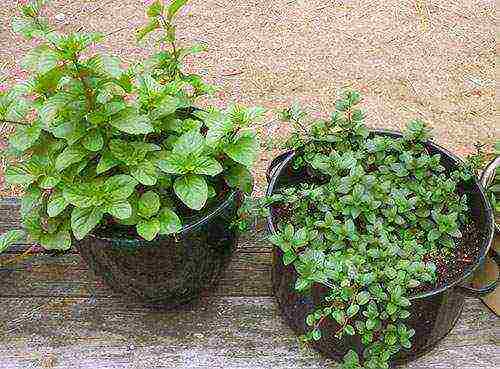 When wondering how to grow mint at home and get strong bushes with juicy bright foliage on the windowsill, it is important to remember that this is possible only if there is the correct temperature regime, watering and sufficient illumination.
When wondering how to grow mint at home and get strong bushes with juicy bright foliage on the windowsill, it is important to remember that this is possible only if there is the correct temperature regime, watering and sufficient illumination.
The temperature comfortable for growth is 20–25 ° С. With this mode, long daylight hours and moist soil, plants form foliage well.
Mint reacts sensitively to changes in illumination, in room conditions, without additional 6-hour illumination in autumn and winter, its shoots begin to stretch, the leaves become smaller, lose their rich color and aroma. If it is impossible to organize the necessary artificial lighting of pots with mint on the windowsill, you can lower the temperature to 15-17 ° C and limit watering. This measure will slow down the growth processes somewhat and will not allow the quality of greenery to decrease.
With all the love of mint for light, the plant does not tolerate being in the sun in direct sunlight. Exposed to the balcony, terrace, loggia or on the windowsill, mint must be shaded, protecting the planting from burns and drying out.
In rooms with a dry atmosphere, especially when heating devices are working, a container with water can be placed next to the mint so that the air humidity does not fall below 80%, which can adversely affect the condition of the bush. For the same purpose, for mint on summer days and in winter, in a warm room, irrigation is carried out with water at room temperature.
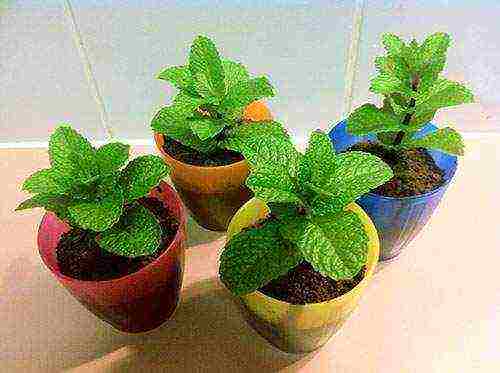 As well as excessive dryness of the air, mint on the windowsill also does not tolerate drying out of the soil. The soil is watered at the first signs of dryness of the upper layer, but at the same time they do not allow stagnation of moisture, which is detrimental to the roots. With a decrease in air temperature, the need for irrigation drops slightly.
As well as excessive dryness of the air, mint on the windowsill also does not tolerate drying out of the soil. The soil is watered at the first signs of dryness of the upper layer, but at the same time they do not allow stagnation of moisture, which is detrimental to the roots. With a decrease in air temperature, the need for irrigation drops slightly.
To simplify the care, as in the photo, for room mint, a little hydrogel can be added to the soil for planting it. Several granules in the soil layer above the drain will allow the soil to retain moisture and fertilizer better.
It is necessary to feed mint grown for greens using nitrogen, potassium and phosphorus fertilizers, but very carefully, since with an excess of nitrogen, the plant can accumulate it in the green.
Timing of collecting mint at home
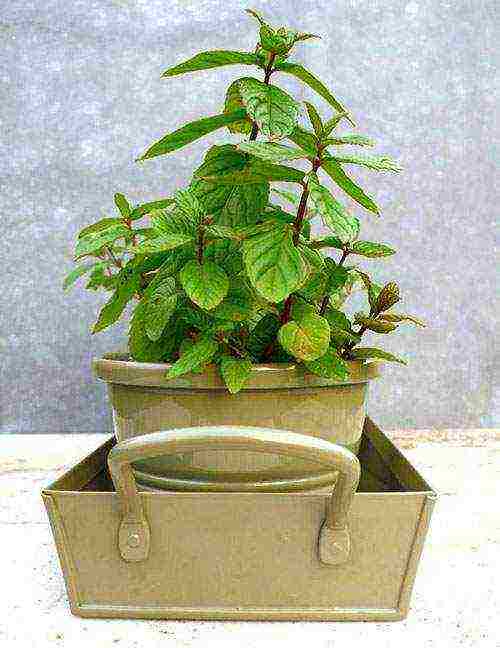 The first crop of home-grown mint is harvested within 15–20 days after the first leaves appear above the ground. By this time, mint bushes reach a height of 20-30 cm, while trimming the tops of the shoots leads to the awakening of the buds in the axils and the growth of the plant.
The first crop of home-grown mint is harvested within 15–20 days after the first leaves appear above the ground. By this time, mint bushes reach a height of 20-30 cm, while trimming the tops of the shoots leads to the awakening of the buds in the axils and the growth of the plant.
If mint is grown in order to obtain raw materials with the maximum content of useful essential oils, then the timing of mint harvesting falls on the moment of peduncle formation or the beginning of flowering. In this case, during the warm season, when growth is most active, you can get up to three full harvests.
Mint, melisa on the windowsill - video
Indoor mint is a popular dietary supplement and tea ingredient loved by housewives. It is dried to get a portion of vitamins in winter. Growing mint at home is essential because its natural properties help relieve stress and promote sound, healthy sleep. How to learn how to grow it competently, observing all the necessary rules? To do this, it is worthwhile to understand the basic recommendations from specialists.
Growing methods
How to grow mint on a windowsill? There are three most common methods preferred by experienced growers: seeds, root cuttings, cuttings, and dividing the bush.
If we talk about the rate of growth and maturation of the mint plant, then the first method is longer in this regard. After all, you will grow mint from scratch - bare seeds. The method of cuttings is much more effective, but you still need to try to get a good viable cuttings. All of these methods allow you to get a plant called indoor mint, but it is worthwhile to understand the features and benefits of each method in more detail.
Seeds
Growing mint at home can include sowing seeds. Perhaps, for not too experienced florists, this method can turn out to be laborious and multi-stage. However, if you want to grow a specific variety of mint on your windowsill, then the best solution is to purchase seeds from a specialized store.
Of course, if opportunities allow, you can assemble them yourself. In this case, be prepared for the fact that the seeds from the parent bushes do not always retain all the characteristic features of the variety. The chances of getting at least some result are low if you want to manually harvest seeds from a hybrid bush. Very often, beginner growers do not pay attention to such moments, but meanwhile, a common garden variety can turn out from a hybrid plant. That is why it is recommended to give preference to store seeds. What is the process of growing mint directly from seeds:
- for a start, it is worth deciding on the optimal period for sowing mint grains into the ground. Sowing is best done in March or April;
- when you sow the seeds into the soil, it is advisable to "cover" them with a layer of nutrient soil or humus on top. Next, the substrate must be covered with glass or transparent film;
- the period from the moment of sowing the seeds is very important for any gardener. It is necessary to provide all the necessary conditions for the mint to sprout soon. Be sure to water or spray the soil. The main thing here is to adhere to the rule of the golden mean, not to overmoisten the soil, but also not to allow it to dry out excessively. Another significant point is the ventilation of the container with mint seeds. Glass or film must be opened a little from time to time;
- after 2-3 weeks, indoor mint will release its first sprouts. Wait until two leaves appear on the plant. After that, it can be dived, replanting sprouts in different flower pots.
Knowing how to grow mint at home using seeds, you can independently get a healthy plant that will delight you with its greenery and refreshing aroma for more than one year.
Root layers
At home, mint does not grow only from seeds. A fairly common way is to propagate it by root layers or by dividing the bush. This houseplant develops quite intensively, it is characterized by the presence of a long and dense root system.Growing up, it gives life to new shoots, which eventually turn into shoots and bushes.
How can this kind of procedure be carried out? It is advisable to do this in August or September. First, select strong root layers, then plant them in moist soil at a depth of about 5-7 cm. Let's say that shoots have already grown on your cuttings. In this case, it is advisable to cut off the sprouts, leaving only a few centimeters of the stem above the ground level. If you are planting a young bush after dividing one large one, you should proceed in the same way. First of all, you need to give time and opportunity for the full development of the root system. Mint grown in a room will eventually become a perennial with medicinal properties, for which it will be enough to take care of it according to basic principles, without being particularly sophisticated.
Using cuttings
Homemade mint grows quite quickly if used for propagation cuttings. It grows stronger and begins to release all new shoots, therefore, in order to obtain results in the near future, it is better to give preference to this method.
Separate the stalk from the main plant and place it in a glass of water for a few days. You can also dig it into the sand. When the mint leaves its roots, it can be planted in moist soil. After that, knowing how to grow indoor mint at home on the windowsill, you will only have to carry out easy, but regular care of the indoor flower.
Video "How to grow mint"
From the video you will learn how to grow mint at home.
Care
In the summer, it is enough to put a flower pot with mint on a windowsill or balcony, because the main thing is that the plant receives enough light. Spray the leaves occasionally to keep the mint from getting dusty.
Mint in a flowerpot does not require too scrupulous care. In winter, you need to take care of the plant much more carefully. It is in winter that mint saturates its stems with essential oil and juice.
It should be watered with room temperature water that has been settled in advance. Also, try to avoid drafts. Among the additional points that are of great importance in ensuring proper care of the grown mint, we can highlight:
- spraying. It should be done regularly, because in this way you allow the plant to breathe;
- replenishment of the soil with special fertilizers. It is undesirable to overdo it here. In the summer, it will be enough to feed the mint once, using 1-2 g of the useful mixture per liter of water. In winter, you can do without fertilizers altogether;
- shaded place. The plant should be saturated with sunlight, but if you put a flowerpot with mint in an open place, direct lighting can simply harm it. Therefore, it is recommended to place the pot of homemade mint in a slightly shaded area.
Homemade mint in a pot will not only be a wonderful green decoration for your indoor garden, but will also be useful in everyday life and cooking.
Video "The healing properties of mint"
From the video you will learn about the beneficial properties of mint.
Part 1 Choosing Species of Mint
-
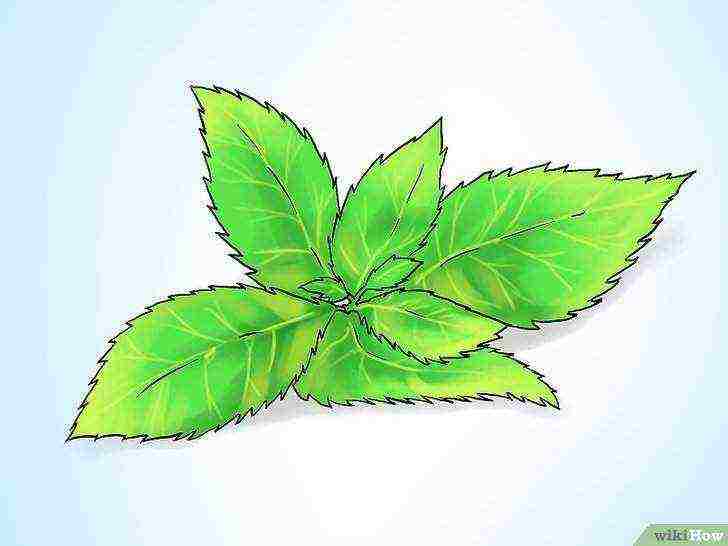
Choose peppermint if you want a brighter, stronger flavor for tea or general use.
-

Use curly mint if your garden, patio, or windows get plenty of light and warmth throughout the year. It is widely used in the southern United States.
-

Plant pineapple mint if you need to plant mint next to other plants. This is one of the less invasive species of mint.
-
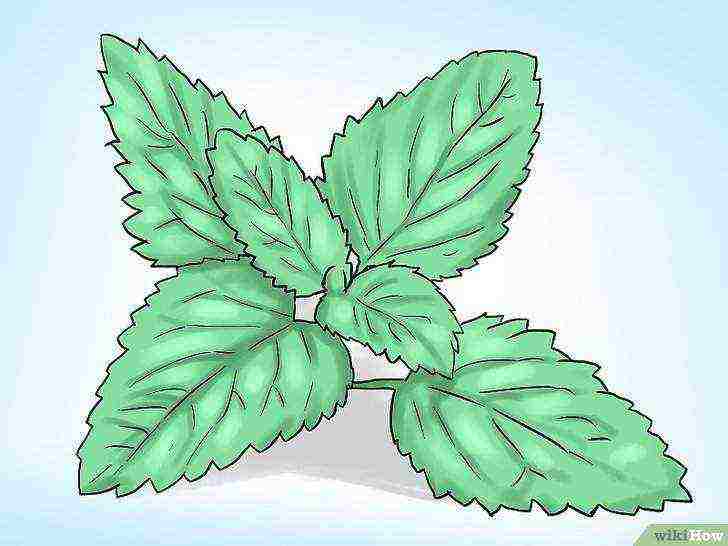
Choose lemon mint if you like the refreshing citrus scent of lemonade or iced tea.
-
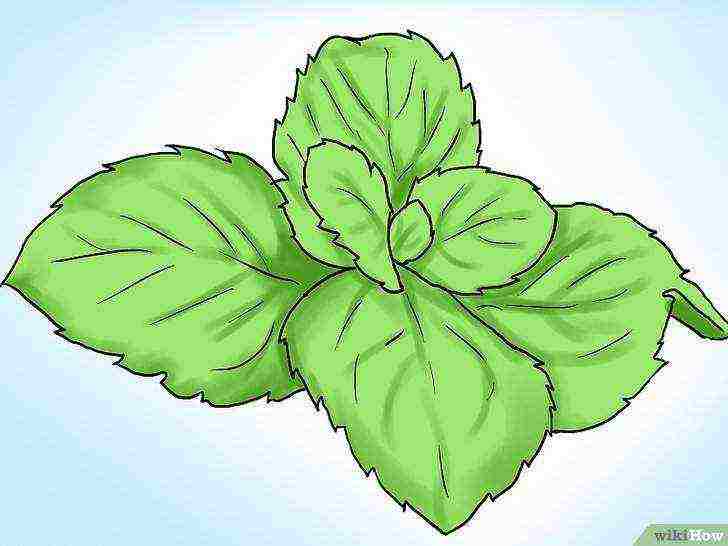
Try apple mint for a subtler aroma with fresh apple notes. This variety is popular in fresh salads and drinks.
Part 2 Planting mint
-
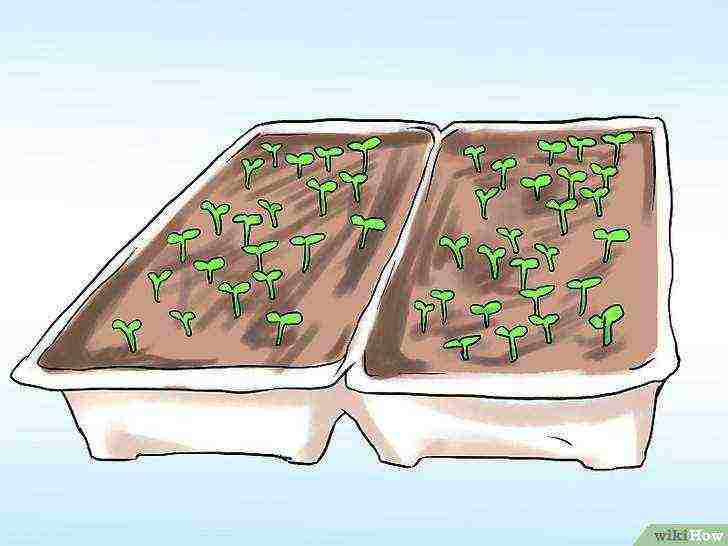 Go to the garden store to buy mint seedlings.
Go to the garden store to buy mint seedlings.
Mint is not easy to grow from seed, so only the most experienced gardeners should start planting mint from seed.Plant it directly in soil or compost after bringing the mint home.
- The garden store will have more varieties of mint, however, you can find mint seedlings and plants at your local farmer's market and supermarket.
-
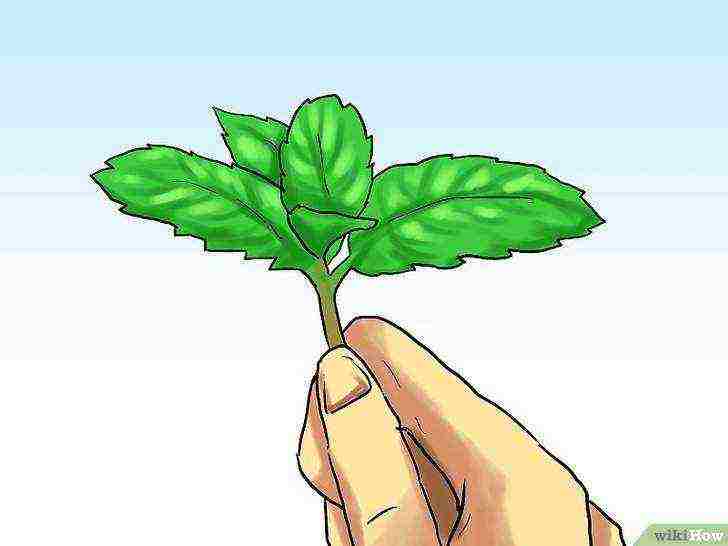
Take a scion from a mature mint plant. Ask a friend if you can use an existing mint in a pot or find one in your garden. Cut with sharp scissors about one centimeter above the stem joint.
-

To use, select the mint, which is picked from the fresh food section of your supermarket. This does not guarantee that you will be able to grow a plant from each cut, but it is a good way to use leftover mint if you want to experiment.
-
 Fill a clean glass with water.
Fill a clean glass with water.
Place the freshly cut twigs in a glass to allow new roots to grow. Keep them in a warm, sunny place and wait for white roots to grow from the cut of the stem.
- Add as much water as needed to keep the glass full.
-
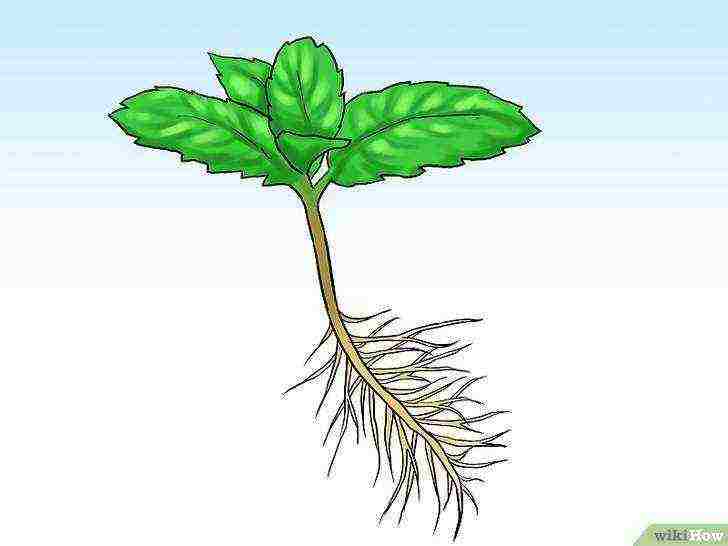
Wait for the white roots to grow 5 cm.before planting. They can even spread to the bottom of the pot.
Part 3 Pot selection
-

Purchase a pot that is at least 30 cm long. in diameter. Mint needs a lot of room to grow.
-
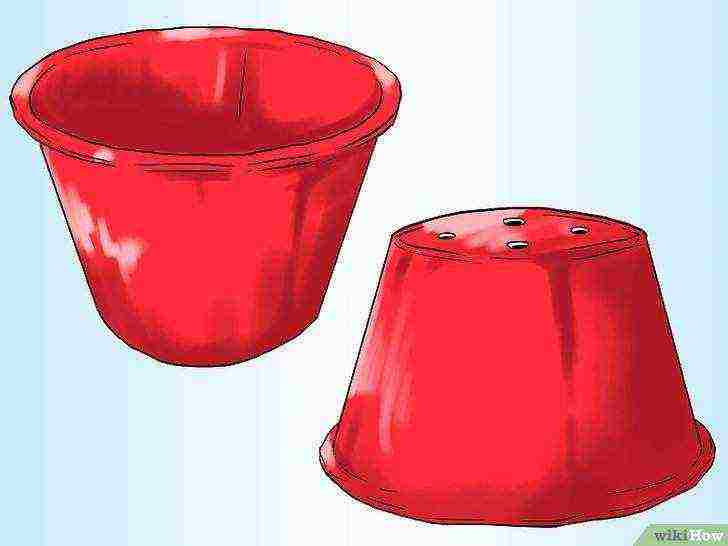
Choose a pot with drainage holes in the bottom. Peppermint thrives in well-drained soil. Get a saucer and place it under the pot to avoid staining your windowsill or patio.
-
 Get an extra, much larger pot if you want to plant mint and other herbs together.
Get an extra, much larger pot if you want to plant mint and other herbs together.
You can put a 30 cm pot in a larger pot next to other herbs. Keep in mind that many varieties of mint will find a way to grab the entire pot through the holes in the bottom of the mint pot.
- If you want to plant mint with other herbs, separate the herbs at the end of the season.
Part 4 Planting mint in a pot
-

Purchase sand compost from your local garden supply store. You can also combine soil with fertile compost. Mint needs fertile and well-drained soil to thrive.
-

Fill a third of the pot with compost and soil.
-
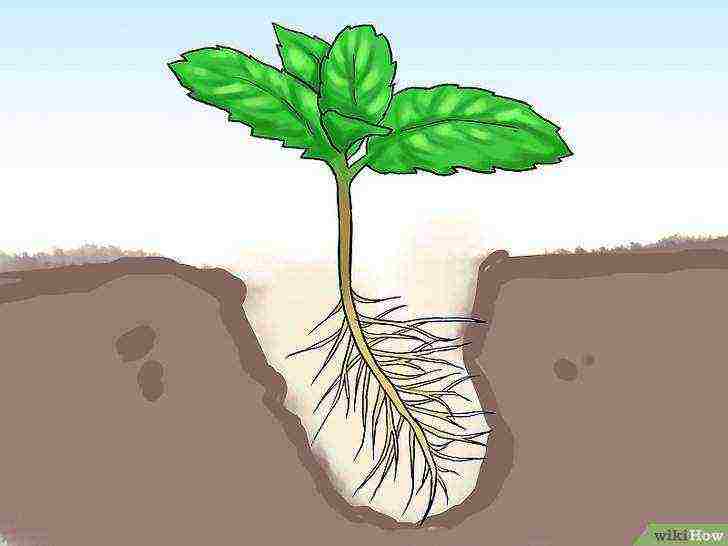
Place a mint shoot or sapling in a pot. Roll up the roots if they are too long for the pot.
-

Fill the area around the mint with soil. Fill the area just enough for the mint to stand on its own.
-
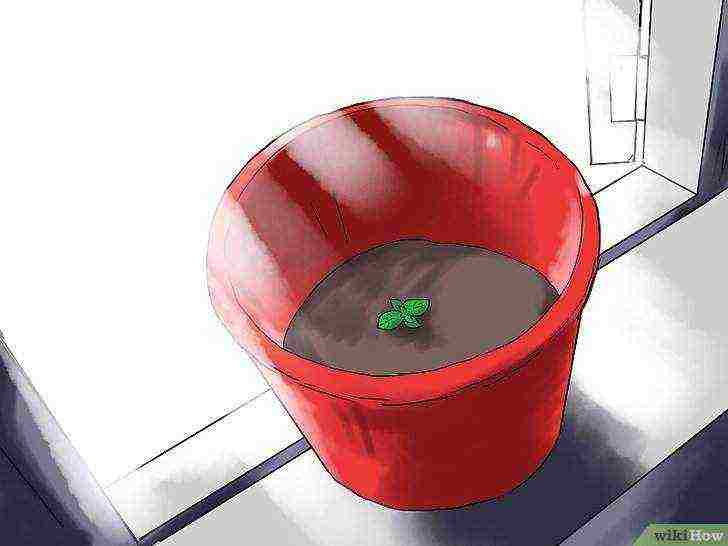 Line a portion of the garden with plastic if you want to plant the pot in soil but also want to keep the mint from spreading.
Line a portion of the garden with plastic if you want to plant the pot in soil but also want to keep the mint from spreading.
Then plant the entire pot in garden soil, letting the pot rise 12 cm above the soil surface.
- If possible, avoid planting mint in your garden. Place it on your patio or windowsill to avoid overgrowth.
-
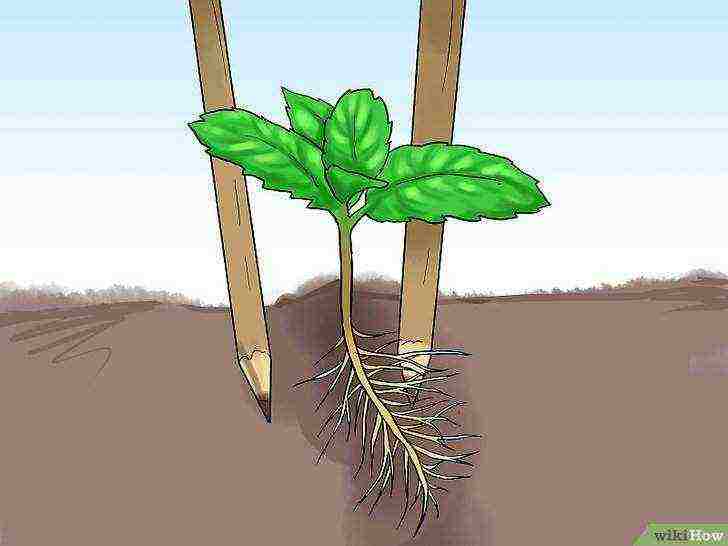
Insert a few wooden dowels next to the plant to support it. They can be removed when the plant is rooted.
Part 5 Caring for potted mint
-
 Water the soil so that it is well saturated.
Water the soil so that it is well saturated.
Water the mint whenever the soil is dry for the first year. The mint should always be moist.
- If the weather is hot, you may need to water the mint several times a day.
-
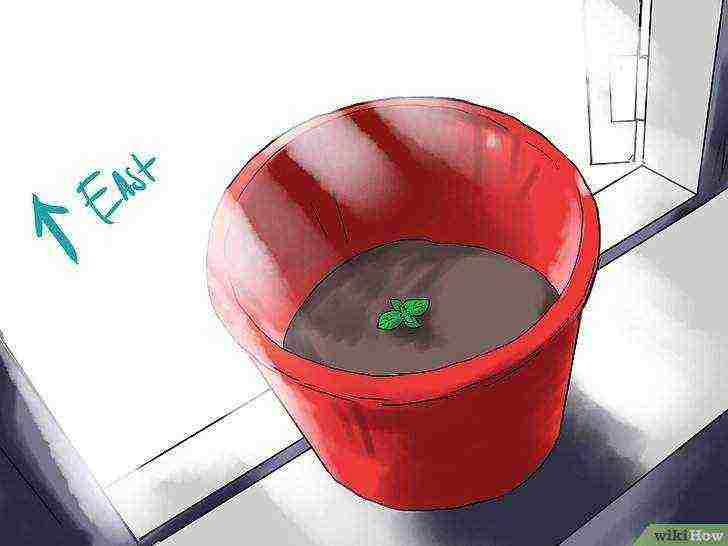
Keep the mint on the east side. Mint enjoys at least six hours of sunshine a day, but it also enjoys being sheltered from the scorching sun of the day. If you have very little sunshine during the winter, the mint tops can die off.
-
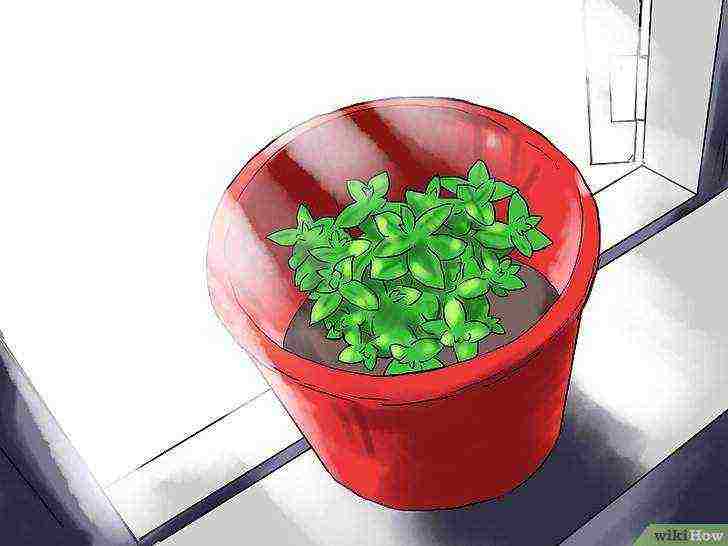
Wait for the mint to grow and the leaves are large before cutting and using the mint. Once the mint has grown, frequent cutting will root the plants and give the leaves a strong scent.
-
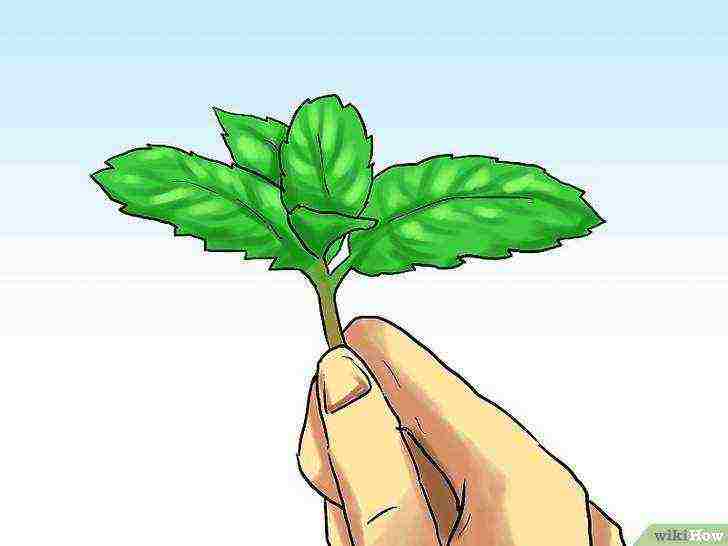 Cut off the top half of the plant with sharp scissors.
Cut off the top half of the plant with sharp scissors.
Cut one centimeter above the stem junction and below the flower buds. Do not trim more than one third of the leaves at a time.
- Never let the mint bloom. The nutrients will be supplied to the flowers and this will slow down the growth of the leaves.
-
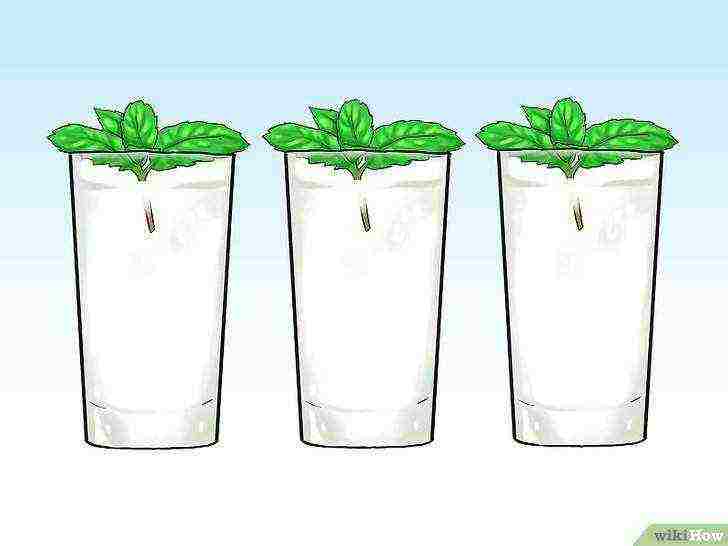
Separate the plants every few years. Cut the soil into quarters and then plant each piece in a new 30cm pot. If you don't split the mint, the plant will suffer and the leaves will not grow well.
What do you need
- Mint seedlings
- Sharp scissors
- Large, mature mint plant
- 30 cm pot with drainage holes
- Saucer
- The soil
- Compost
- Windowsill
- Water
- Cup
- Wooden skewers
Article Information
This page has been viewed 120,388 times.
Was this helpful?

